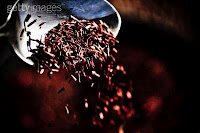Red tea is technically an herbal tea – which is a broad category and one that is quickly gaining in popularity alongside green and white teas. With its wide range of flavors and profiles and its complete lack of caffeine, herbal tea is an ideal offering for large (and often picky) groups of people.
Red and Herbal teas are not like green, white, black, and oolong, which are made from the Camellia sinensis plant. In fact, reds and herbals aren’t actually teas (the phrases are misnomers). True teas are all and only made from the C. sinensis plant – the color of a tea is determined by the degree of processing it undergoes. Herbal infusions, then, are called tisanes or ptisans, a Greek word for a drink made from pearl barley. So-called ‘red tea’ is a tisane of the rooibos, (Afrikaans for red bush) or African red bush plant.
Because herbal tisanes are not made from the C. sinensis plant, they have no caffeine. Some of the plants used to make tisanes are, however, said to have stimulant properties. This is on a case-by-case basis and is the province of herbalism.
Preparing herbal and red tisanes is fairly simple. Most are brewed with freshly boiled water for an initial steep of three to five minutes. While commercial tisanes may have specific instructions, any homemade tisane will do well with this standard steeping guideline.
Red, or rooibos, tisanes were developed by the Dutch settlers to the Western Cape region of South Africa as an alternative tea to the expensive sea-trade shipments of black tea at the time. The red bush plant is only grown in that particular region, but the popularity of the ‘tea’ has spread worldwide. It provides significant antioxidants such as aspalathin and nothofagin as well as other phenolic compounds. While official studies on health benefits are scarce, rooibos tisanes are said to assist with nervous tension, allergies, digestive problems, infantile colic, asthma and dermatological problems.
The broader category of herbal tisanes is reminiscent of the potions or witches’ brews of yore. Although many herbal tisanes are blended purely for flavor, most tout some medicinal value. Virtually every part of any plant can be boiled to produce a ‘tea’ – some will heal, some will poison, and some will do both in different doses. Here’s a quick list of some of the commonly used medicinal plants and their purported properties:
- Blackberry Leaf – prevents skin wrinkles
- Catnip – sedative (believe it or not)
- Calendula – treats cramps and constipation
- Dill – treats upset stomach
- Echinacea – boosts immune system to fight the common cold
- Fennel – used for weightloss and vision problems
- Feverfew – treats migraine headaches (not for pregnant women)
- Ginger – treats/prevents nausea
- Hawthorn – lower cholesterol
- Kava Root – promotes talkativeness and relaxation
- Ku Ding – blood thinner like Aspirin
- Lemongrass – lowers cholesterol
- Milk Thistle – repairs the liver
- Peppermint – stimulant, prevents irritable bowels
- Snakeroot (Indian) – treats sleeplessness and anxiety
- Rose Hips – treats osteoarthritis
- Rosemary – enhance memory
- St. John’s Wort – anti-depressant
- Stinging Nettle – anti-inflammatory
- Valerian Root – treats insomnia
- Yarrow – has been used to treat almost anything and everything, generally a healing herb
- Chamomile – antispasmodic, anxiolytic, anti-inflammatory, antimutagenic, antioxidant, antimicrobial, antiviral, lowers cholesterol, and fights cancer
I’ll admit the alchemic appeal of concocting my own aromatic and healing brews has fascinated me since I was knee-high to a grasshopper. My favorite herbs are rosemary, peppermint, and yarrow (not together). If you have a favorite herbal tisane blend or product, leave it here in the comments.
Leave your feedback and share this page to keep the discussion going!
Here’s a low-cost, five-star-rated tea to start you on your journey. Twinings is always a win; if you’ll like rooibos, you’ll like this. Quick tip: Red tisanes are known for losing their flavor after the first brew. Don’t waste your time; use a new bag for each mug.
Unless otherwise sourced, all information comes from Wikipedia and its prodigious list of sources.
Photo credits: Rooibos Tea by Sheila Paras
Herbal Tea by Thorsten Kraska

 Red tea is technically an herbal tea – which is a broad category and one that is quickly gaining in popularity alongside green and white teas. With its wide range of flavors and profiles and its complete lack of caffeine, herbal tea is an ideal offering for large (and often picky) groups of people.
Red tea is technically an herbal tea – which is a broad category and one that is quickly gaining in popularity alongside green and white teas. With its wide range of flavors and profiles and its complete lack of caffeine, herbal tea is an ideal offering for large (and often picky) groups of people.

2 pings